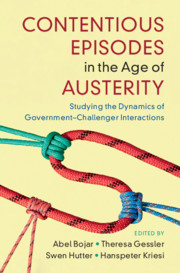 Contentious Episodes in the Age of Austerity
Contentious Episodes in the Age of Austerity from Part IV - Conclusion
Published online by Cambridge University Press: 05 November 2021
At the outset of this volume, we situated our approach between two main paradigms prevailing in the field of contentious politics, taking up the challenge that Tilly (2008) put forward more than a decade ago. One, epitomized by the “narrative” approach, focuses on conventional storytelling, where explanation takes the form of an unfolding open-ended story. The other, protest event analysis (PEA) (see Hutter, 2014 and Koopmans and Rucht, 2002 for reviews), or what we called the epidemiological approach, focuses on a narrower set of action types: namely, instances of popular mobilization in the streets, and primarily relies on statistical techniques to explain the temporal regularities of protest actions or protest waves (Lorenzini et al, 2020). We aimed to accomplish this task by drawing on the programmatic Dynamics of Contention (McAdam et al. 2001) with an eye on preserving the conceptual depth of the former infused with the methodological rigor of the latter. In addressing “the middle ground” favored by Charles Tilly, we applied an analytical approach to the study of the dynamics of contention that allows for the systematic comparative analysis of causal patterns across individual narratives.
To save this book to your Kindle, first ensure [email protected] is added to your Approved Personal Document E-mail List under your Personal Document Settings on the Manage Your Content and Devices page of your Amazon account. Then enter the ‘name’ part of your Kindle email address below. Find out more about saving to your Kindle.
Note you can select to save to either the @free.kindle.com or @kindle.com variations. ‘@free.kindle.com’ emails are free but can only be saved to your device when it is connected to wi-fi. ‘@kindle.com’ emails can be delivered even when you are not connected to wi-fi, but note that service fees apply.
Find out more about the Kindle Personal Document Service.
To save content items to your account, please confirm that you agree to abide by our usage policies. If this is the first time you use this feature, you will be asked to authorise Cambridge Core to connect with your account. Find out more about saving content to Dropbox.
To save content items to your account, please confirm that you agree to abide by our usage policies. If this is the first time you use this feature, you will be asked to authorise Cambridge Core to connect with your account. Find out more about saving content to Google Drive.